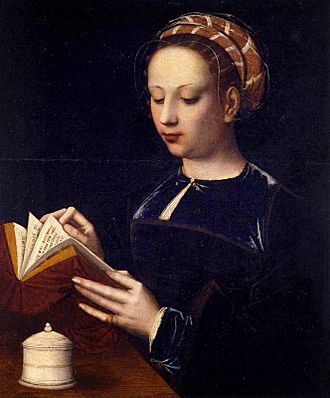Ambrosius Benson facts for kids
Ambrosius Benson (born around 1495-1500 in Italy, died 1550 in Flanders) was an important painter. He was Italian by birth but became a key part of the Northern Renaissance art movement.
Even though many of his paintings still exist, we don't know much about his life from old records. He usually didn't sign his artwork. Benson mostly painted religious scenes. He also created portraits for people who hired him. Sometimes, he painted scenes from old stories, but he would show the characters in modern clothes or in everyday settings. He was very successful during his lifetime. He had a large workshop and his art was sold all over the world, especially in Spain.
Later, in the 1800s, other painters copied Benson's style. They are sometimes called "followers of Benson." His many paintings of Mary Magdalene and the Sibyl Persica were especially popular and copied often.
Contents
About Ambrosius Benson
Early Life and Training
Ambrosius Benson was born in Italy, but he is known as a painter from the Flemish school. Like many artists of his time, he traveled for his work. Around 1515, he moved to Bruges, a city in Flanders (modern-day Belgium). There, he became an apprentice to Gerard David, another important painter.
Benson later became a citizen of Bruges. He worked as a journeyman, which means he was a skilled worker who traveled from place to place. In 1519, he became a master painter. This meant he could open his own workshop and train apprentices. He also joined the local guild for painters and saddle makers. He even became a leader of this guild, serving as a dean and then a governor.
Family and Disagreements
Ambrosius Benson married Anna Ghyselin. They had two sons, Jan and Willem, who both grew up to be painters. He later married again and had a daughter named Anna. He is also believed to have had at least two other daughters with other women.
Around 1519, Benson had a disagreement with his former teacher, Gerard David. Benson had created some paintings and drawings in David's workshop without David's help. David refused to give these artworks back to Benson. Benson took legal action, and David faced consequences for keeping the art.
Guild Leadership and Famous Works
Benson was a respected artist. He served as the head of the Guild of Saint Luke (the painters' guild) from 1537 to 1539 and again from 1543 to 1544. For a long time, many of his paintings were thought to be by a Spanish artist known only as the Master of Segovia. Now, experts believe they were the same person. This is why many of Benson's best artworks are found in Spanish museums and churches. These include the Prado Museum and the Bilbao Fine Arts Museum.
Benson was one of the first artists to make paintings of women reading very popular. He may have been inspired by Rogier van der Weyden's 15th-century painting, The Magdalen Reading. Painting women reading became a common theme for Benson. He painted this scene many times in his pictures of Mary Magdalen and the Sybil Persica. He often made these two figures look very similar. One of Benson's The Magdalen Reading paintings is kept at the National Gallery in London.
Gallery
-
Portrait of Anne Stafford, 1535
See also
 In Spanish: Ambrosius Benson para niños
In Spanish: Ambrosius Benson para niños











